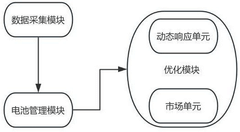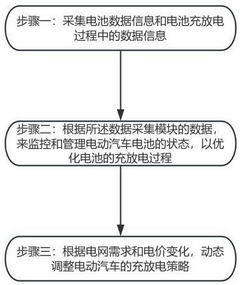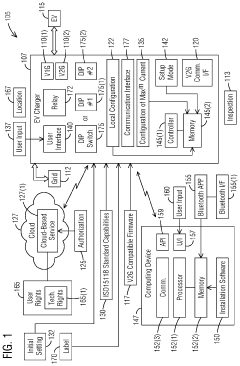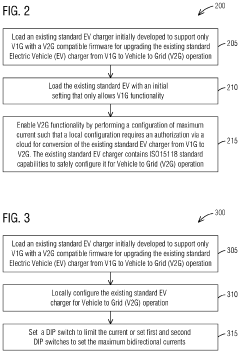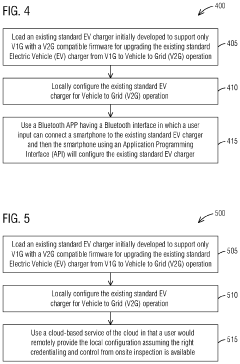How V2G Enhances Resilience Against Power Disruptions?
AUG 8, 20259 MIN READ
Generate Your Research Report Instantly with AI Agent
Patsnap Eureka helps you evaluate technical feasibility & market potential.
V2G Technology Background and Objectives
Vehicle-to-Grid (V2G) technology has emerged as a promising solution to enhance power grid resilience and mitigate the impact of power disruptions. This innovative approach leverages the energy storage capabilities of electric vehicles (EVs) to create a bidirectional flow of electricity between vehicles and the power grid. The concept of V2G has evolved over the past two decades, driven by the increasing adoption of EVs and the growing need for grid stability in the face of renewable energy integration.
The primary objective of V2G technology is to transform EVs from mere consumers of electricity into active participants in the power ecosystem. By enabling EVs to feed stored energy back into the grid during peak demand periods or power outages, V2G aims to enhance grid reliability, reduce strain on traditional power infrastructure, and provide a decentralized energy storage solution. This technology aligns with broader goals of creating a more resilient, flexible, and sustainable energy system.
The evolution of V2G technology can be traced back to the early 2000s when researchers first proposed the concept of using EV batteries as distributed energy resources. Since then, advancements in battery technology, power electronics, and smart grid infrastructure have accelerated the development of V2G systems. Key milestones include the introduction of bidirectional chargers, the development of communication protocols for grid integration, and the implementation of pilot projects demonstrating the feasibility of V2G in real-world scenarios.
As the global energy landscape shifts towards renewable sources, V2G technology is poised to play a crucial role in addressing the intermittency challenges associated with solar and wind power. By providing a vast network of mobile energy storage units, V2G can help balance supply and demand, smooth out power fluctuations, and reduce the need for costly grid upgrades. Furthermore, V2G technology aims to create new revenue streams for EV owners, potentially offsetting the higher upfront costs of electric vehicles and accelerating their adoption.
The technical objectives of V2G technology include developing efficient bidirectional charging systems, optimizing battery management to minimize degradation, and creating sophisticated algorithms for coordinating large fleets of EVs. Additionally, there is a focus on enhancing cybersecurity measures to protect the grid from potential vulnerabilities introduced by widespread V2G implementation. As the technology matures, researchers and industry players are working towards standardizing V2G protocols and integrating them seamlessly into existing grid management systems.
In the context of power disruptions, V2G technology aims to provide a rapid and distributed response mechanism. By tapping into the collective energy storage capacity of thousands or even millions of EVs, grid operators can potentially mitigate the impact of localized outages or widespread blackouts. This capability is particularly valuable in scenarios where traditional backup power systems may be insufficient or slow to respond. The ultimate goal is to create a more resilient power infrastructure that can withstand and quickly recover from various types of disruptions, ranging from equipment failures to natural disasters.
The primary objective of V2G technology is to transform EVs from mere consumers of electricity into active participants in the power ecosystem. By enabling EVs to feed stored energy back into the grid during peak demand periods or power outages, V2G aims to enhance grid reliability, reduce strain on traditional power infrastructure, and provide a decentralized energy storage solution. This technology aligns with broader goals of creating a more resilient, flexible, and sustainable energy system.
The evolution of V2G technology can be traced back to the early 2000s when researchers first proposed the concept of using EV batteries as distributed energy resources. Since then, advancements in battery technology, power electronics, and smart grid infrastructure have accelerated the development of V2G systems. Key milestones include the introduction of bidirectional chargers, the development of communication protocols for grid integration, and the implementation of pilot projects demonstrating the feasibility of V2G in real-world scenarios.
As the global energy landscape shifts towards renewable sources, V2G technology is poised to play a crucial role in addressing the intermittency challenges associated with solar and wind power. By providing a vast network of mobile energy storage units, V2G can help balance supply and demand, smooth out power fluctuations, and reduce the need for costly grid upgrades. Furthermore, V2G technology aims to create new revenue streams for EV owners, potentially offsetting the higher upfront costs of electric vehicles and accelerating their adoption.
The technical objectives of V2G technology include developing efficient bidirectional charging systems, optimizing battery management to minimize degradation, and creating sophisticated algorithms for coordinating large fleets of EVs. Additionally, there is a focus on enhancing cybersecurity measures to protect the grid from potential vulnerabilities introduced by widespread V2G implementation. As the technology matures, researchers and industry players are working towards standardizing V2G protocols and integrating them seamlessly into existing grid management systems.
In the context of power disruptions, V2G technology aims to provide a rapid and distributed response mechanism. By tapping into the collective energy storage capacity of thousands or even millions of EVs, grid operators can potentially mitigate the impact of localized outages or widespread blackouts. This capability is particularly valuable in scenarios where traditional backup power systems may be insufficient or slow to respond. The ultimate goal is to create a more resilient power infrastructure that can withstand and quickly recover from various types of disruptions, ranging from equipment failures to natural disasters.
Market Analysis for V2G Resilience Solutions
The market for Vehicle-to-Grid (V2G) resilience solutions is experiencing significant growth as power grid vulnerabilities become increasingly apparent. The global V2G market is projected to expand rapidly, driven by the rising adoption of electric vehicles (EVs) and the growing need for grid stability. This market encompasses hardware, software, and services that enable bidirectional power flow between EVs and the grid, allowing vehicles to act as mobile energy storage units during power disruptions.
Key market drivers include the increasing frequency of extreme weather events, aging power infrastructure, and the transition to renewable energy sources, which can introduce intermittency challenges. Governments and utilities worldwide are recognizing the potential of V2G technology to enhance grid resilience, leading to supportive policies and incentives. For instance, some regions offer reduced electricity rates or direct payments to EV owners who participate in V2G programs.
The demand for V2G resilience solutions is particularly strong in areas prone to natural disasters or with unreliable power grids. Urban centers with high EV adoption rates and forward-thinking energy policies are also prime markets for these technologies. Additionally, commercial and industrial sectors are showing interest in V2G as a means to reduce energy costs and ensure business continuity during outages.
Market segmentation reveals opportunities across various applications. Residential V2G systems are gaining traction among homeowners seeking energy independence and backup power. Commercial fleets, including delivery vehicles and public transportation, represent a significant market segment due to their predictable schedules and large battery capacities. Utility-scale V2G implementations are also emerging as power companies explore ways to leverage EV batteries for grid balancing and peak shaving.
The competitive landscape is diverse, with established automotive manufacturers, charging infrastructure providers, and energy management companies entering the V2G market. Startups focusing on innovative V2G software platforms and integration solutions are also proliferating. This has led to a range of business models, from direct hardware sales to subscription-based services that manage V2G participation for EV owners.
Despite the promising outlook, challenges remain. Consumer awareness and acceptance of V2G technology are still limited in many regions. Concerns about battery degradation and the complexity of V2G systems need to be addressed to drive wider adoption. Additionally, standardization of V2G protocols and interoperability between different EV models and charging systems are ongoing issues that impact market growth.
Key market drivers include the increasing frequency of extreme weather events, aging power infrastructure, and the transition to renewable energy sources, which can introduce intermittency challenges. Governments and utilities worldwide are recognizing the potential of V2G technology to enhance grid resilience, leading to supportive policies and incentives. For instance, some regions offer reduced electricity rates or direct payments to EV owners who participate in V2G programs.
The demand for V2G resilience solutions is particularly strong in areas prone to natural disasters or with unreliable power grids. Urban centers with high EV adoption rates and forward-thinking energy policies are also prime markets for these technologies. Additionally, commercial and industrial sectors are showing interest in V2G as a means to reduce energy costs and ensure business continuity during outages.
Market segmentation reveals opportunities across various applications. Residential V2G systems are gaining traction among homeowners seeking energy independence and backup power. Commercial fleets, including delivery vehicles and public transportation, represent a significant market segment due to their predictable schedules and large battery capacities. Utility-scale V2G implementations are also emerging as power companies explore ways to leverage EV batteries for grid balancing and peak shaving.
The competitive landscape is diverse, with established automotive manufacturers, charging infrastructure providers, and energy management companies entering the V2G market. Startups focusing on innovative V2G software platforms and integration solutions are also proliferating. This has led to a range of business models, from direct hardware sales to subscription-based services that manage V2G participation for EV owners.
Despite the promising outlook, challenges remain. Consumer awareness and acceptance of V2G technology are still limited in many regions. Concerns about battery degradation and the complexity of V2G systems need to be addressed to drive wider adoption. Additionally, standardization of V2G protocols and interoperability between different EV models and charging systems are ongoing issues that impact market growth.
V2G Resilience: Current State and Challenges
Vehicle-to-Grid (V2G) technology has emerged as a promising solution to enhance power grid resilience against disruptions. However, the current state of V2G implementation faces several challenges that need to be addressed for widespread adoption and effective utilization.
One of the primary challenges is the limited availability of V2G-capable electric vehicles (EVs) and charging infrastructure. While the number of EVs on the roads is increasing, only a small percentage are equipped with bidirectional charging capabilities necessary for V2G operations. This limitation restricts the potential impact of V2G on grid resilience.
Technical integration challenges also persist. The seamless communication between EVs, charging stations, and the power grid requires sophisticated software and hardware systems. Standardization of protocols and interfaces across different EV manufacturers and grid operators is still in progress, hindering interoperability and scalability of V2G solutions.
Battery degradation concerns present another significant hurdle. Frequent charging and discharging cycles associated with V2G operations may accelerate battery wear, potentially reducing the lifespan of EV batteries. This issue raises concerns among EV owners and manufacturers, impacting the willingness to participate in V2G programs.
Regulatory frameworks and market structures pose additional challenges. Many regions lack clear policies and regulations governing V2G operations, creating uncertainty for stakeholders. Furthermore, existing electricity market structures may not adequately compensate EV owners for the grid services they provide, diminishing the economic incentives for participation.
Grid operators face challenges in managing the dynamic nature of V2G resources. The unpredictable availability of EVs for grid support, influenced by factors such as driving patterns and user preferences, complicates grid planning and operation. Developing robust forecasting and control algorithms to effectively utilize V2G resources remains an ongoing challenge.
Cybersecurity concerns also loom large in the V2G landscape. The increased connectivity between EVs and the grid creates potential vulnerabilities that could be exploited by malicious actors. Ensuring the security and integrity of V2G communications and transactions is crucial for maintaining grid stability and protecting user privacy.
Despite these challenges, progress is being made in addressing these issues. Pilot projects and research initiatives are demonstrating the potential of V2G to enhance grid resilience. Advancements in battery technology, smart charging algorithms, and regulatory frameworks are gradually overcoming some of the obstacles. As the technology matures and stakeholders collaborate to address these challenges, V2G is poised to play an increasingly important role in fortifying power grids against disruptions.
One of the primary challenges is the limited availability of V2G-capable electric vehicles (EVs) and charging infrastructure. While the number of EVs on the roads is increasing, only a small percentage are equipped with bidirectional charging capabilities necessary for V2G operations. This limitation restricts the potential impact of V2G on grid resilience.
Technical integration challenges also persist. The seamless communication between EVs, charging stations, and the power grid requires sophisticated software and hardware systems. Standardization of protocols and interfaces across different EV manufacturers and grid operators is still in progress, hindering interoperability and scalability of V2G solutions.
Battery degradation concerns present another significant hurdle. Frequent charging and discharging cycles associated with V2G operations may accelerate battery wear, potentially reducing the lifespan of EV batteries. This issue raises concerns among EV owners and manufacturers, impacting the willingness to participate in V2G programs.
Regulatory frameworks and market structures pose additional challenges. Many regions lack clear policies and regulations governing V2G operations, creating uncertainty for stakeholders. Furthermore, existing electricity market structures may not adequately compensate EV owners for the grid services they provide, diminishing the economic incentives for participation.
Grid operators face challenges in managing the dynamic nature of V2G resources. The unpredictable availability of EVs for grid support, influenced by factors such as driving patterns and user preferences, complicates grid planning and operation. Developing robust forecasting and control algorithms to effectively utilize V2G resources remains an ongoing challenge.
Cybersecurity concerns also loom large in the V2G landscape. The increased connectivity between EVs and the grid creates potential vulnerabilities that could be exploited by malicious actors. Ensuring the security and integrity of V2G communications and transactions is crucial for maintaining grid stability and protecting user privacy.
Despite these challenges, progress is being made in addressing these issues. Pilot projects and research initiatives are demonstrating the potential of V2G to enhance grid resilience. Advancements in battery technology, smart charging algorithms, and regulatory frameworks are gradually overcoming some of the obstacles. As the technology matures and stakeholders collaborate to address these challenges, V2G is poised to play an increasingly important role in fortifying power grids against disruptions.
Existing V2G Resilience Implementations
01 Grid stabilization and load balancing
V2G technology enables electric vehicles to act as mobile energy storage units, contributing to grid stability and load balancing. During peak demand periods, EVs can feed power back to the grid, helping to reduce strain on the electrical infrastructure and improve overall system resilience.- Grid stabilization and load balancing: V2G technology enables electric vehicles to act as mobile energy storage units, contributing to grid stability and load balancing. During peak demand periods, EVs can feed power back to the grid, helping to reduce strain on the electrical infrastructure and improve overall system resilience.
- Emergency power supply during outages: V2G-enabled vehicles can serve as emergency power sources during grid outages or natural disasters. This capability enhances community resilience by providing backup power to critical infrastructure or individual households when the main power supply is disrupted.
- Renewable energy integration: V2G systems can support the integration of renewable energy sources by storing excess energy generated during peak production times and releasing it when demand is high or renewable generation is low. This helps to smooth out the intermittency of renewable sources and increase grid resilience.
- Smart charging and demand response: V2G technology enables smart charging strategies that can respond to real-time grid conditions. By adjusting charging patterns based on grid demand and electricity prices, V2G systems can help prevent overloading and improve overall grid resilience while potentially reducing costs for EV owners.
- Microgrid support and islanding capabilities: V2G-equipped vehicles can support microgrid operations, allowing for the creation of localized power systems that can operate independently from the main grid. This capability enhances resilience by enabling communities or facilities to maintain power supply during widespread outages or grid disturbances.
02 Emergency power supply during outages
V2G-enabled vehicles can serve as emergency power sources during grid failures or natural disasters. This capability enhances community resilience by providing backup power to critical infrastructure or individual households when the main power supply is disrupted.Expand Specific Solutions03 Renewable energy integration
V2G systems can support the integration of renewable energy sources by storing excess energy generated during peak production times and releasing it when demand is high or renewable generation is low. This helps to smooth out the intermittency of renewable sources and increases grid resilience.Expand Specific Solutions04 Smart charging and demand response
V2G technology enables smart charging strategies that can respond to real-time grid conditions. By adjusting charging patterns based on grid demand and electricity prices, V2G systems can help prevent overloads and reduce stress on the electrical infrastructure, thereby enhancing overall system resilience.Expand Specific Solutions05 Microgrid support and islanding capabilities
V2G-equipped vehicles can support microgrid operations, allowing for the creation of self-sustaining energy islands during grid disturbances. This capability enhances local resilience by maintaining power supply to critical loads and facilitating faster recovery from widespread outages.Expand Specific Solutions
Key Players in V2G and Grid Resilience
The V2G (Vehicle-to-Grid) technology market is in its early growth stage, with increasing interest from automotive manufacturers, utility companies, and energy providers. The market size is expanding, driven by the growing adoption of electric vehicles and the need for grid stability. Technologically, V2G is still evolving, with companies like Honda Motor Co., Ltd. and Toyota Motor Corp. leading research and development efforts. State Grid Corp. of China and its subsidiaries are actively exploring V2G applications in large-scale grid management. Academic institutions such as Wuhan University of Technology and China Three Gorges University are contributing to technological advancements. While V2G shows promise in enhancing power grid resilience, widespread implementation faces challenges in standardization and infrastructure development.
State Grid Corp. of China
Technical Solution: State Grid Corp. of China has developed a comprehensive V2G (Vehicle-to-Grid) system to enhance power grid resilience. Their approach integrates large-scale electric vehicle (EV) fleets with the power grid, allowing bidirectional power flow. This system utilizes advanced power electronics and smart charging stations to enable EVs to feed electricity back to the grid during peak demand or emergencies. State Grid has implemented a dynamic pricing mechanism to incentivize EV owners to participate in V2G services, optimizing grid stability and reducing the risk of power disruptions[1]. The company has also developed a sophisticated energy management system that predicts grid demand and coordinates V2G operations across multiple regions, ensuring a more resilient and flexible power infrastructure[3].
Strengths: Extensive power grid infrastructure, large-scale implementation capability, and advanced energy management systems. Weaknesses: Potential challenges in coordinating with multiple EV manufacturers and ensuring widespread consumer adoption.
Honda Motor Co., Ltd.
Technical Solution: Honda has developed a V2G system called "Honda Power Exporter 9000," which enables their electric vehicles to function as mobile power sources during emergencies or power disruptions. This system allows Honda EVs to supply up to 9 kW of power, sufficient to run home appliances or critical equipment. Honda's V2G technology incorporates intelligent power management algorithms that optimize the vehicle's battery usage while ensuring sufficient charge for driving needs. The company has also introduced a "Smart Power Parking" concept, where EVs can automatically connect to the grid when parked, providing seamless integration with power systems[2]. Honda is collaborating with utility companies to pilot V2G programs, demonstrating the potential for EVs to serve as distributed energy resources and enhance grid resilience[5].
Strengths: Innovative V2G hardware solutions, integration with existing EV models, and partnerships with utility companies. Weaknesses: Limited to Honda vehicles, potentially reducing widespread adoption and impact on overall grid resilience.
Core V2G Resilience Technologies
A dynamic regulation system and method for electric vehicles participating in power grid based on V2G technology
PatentActiveCN118651117B
Innovation
- The data acquisition module is used to monitor battery status. The battery management module dynamically adjusts the charge and discharge strategy based on comprehensive evaluation values and changes in electricity prices. The optimization module includes a dynamic response unit and a market unit, a predictive maintenance unit and a charge and discharge adjustment factor to achieve intelligent charge and discharge management and economy. excitation.
Upgrading an existing standard electric vehicle (EV) charger from grid to vehicle (V1G) to v1g plus vehicle to grid (V2G) operation
PatentPendingUS20240201974A1
Innovation
- A method to locally configure existing standard AC EV chargers with ISO15118 capabilities for V2G operation by loading V2G compatible firmware, authorizing via the cloud, and configuring maximum current, allowing bi-directional charging/discharging through a communication interface.
Regulatory Framework for V2G Integration
The regulatory framework for Vehicle-to-Grid (V2G) integration plays a crucial role in enhancing power grid resilience against disruptions. As V2G technology gains traction, policymakers and regulatory bodies are developing comprehensive guidelines to ensure its seamless integration into existing power systems.
One of the primary focuses of V2G regulatory frameworks is the establishment of clear standards for bidirectional charging infrastructure. These standards encompass technical specifications, safety protocols, and interoperability requirements for V2G-enabled vehicles and charging stations. By setting uniform standards, regulators aim to facilitate widespread adoption and ensure compatibility across different vehicle models and charging networks.
Another key aspect of V2G regulation is the development of market mechanisms that incentivize participation in grid services. This includes designing tariff structures that reward EV owners for providing ancillary services, such as frequency regulation and voltage support. Regulatory bodies are working to create fair compensation models that balance the interests of EV owners, utilities, and grid operators.
Data privacy and cybersecurity are also critical components of V2G regulatory frameworks. As V2G systems involve the exchange of sensitive information between vehicles, charging stations, and grid operators, regulators are implementing stringent data protection measures. These include encryption standards, access controls, and protocols for secure communication to safeguard against potential cyber threats.
The regulatory landscape for V2G integration also addresses grid interconnection requirements. This involves defining the technical and operational criteria for connecting V2G-enabled vehicles to the power grid. Regulators are establishing guidelines for power quality, grid stability, and fault protection to ensure that V2G systems do not compromise the reliability of the existing infrastructure.
Furthermore, V2G regulations are evolving to accommodate the unique challenges of distributed energy resources. This includes developing frameworks for aggregating multiple V2G-enabled vehicles into virtual power plants, allowing them to participate in wholesale electricity markets. Regulators are working on rules for bidding, dispatch, and settlement processes that enable these aggregated resources to compete effectively with traditional power generators.
Lastly, V2G regulatory frameworks are addressing the need for consumer protection and education. This involves setting guidelines for transparent pricing, clear communication of terms and conditions, and dispute resolution mechanisms. Regulators are also promoting awareness campaigns to educate consumers about the benefits and responsibilities of participating in V2G programs, ensuring informed decision-making and fostering public trust in the technology.
One of the primary focuses of V2G regulatory frameworks is the establishment of clear standards for bidirectional charging infrastructure. These standards encompass technical specifications, safety protocols, and interoperability requirements for V2G-enabled vehicles and charging stations. By setting uniform standards, regulators aim to facilitate widespread adoption and ensure compatibility across different vehicle models and charging networks.
Another key aspect of V2G regulation is the development of market mechanisms that incentivize participation in grid services. This includes designing tariff structures that reward EV owners for providing ancillary services, such as frequency regulation and voltage support. Regulatory bodies are working to create fair compensation models that balance the interests of EV owners, utilities, and grid operators.
Data privacy and cybersecurity are also critical components of V2G regulatory frameworks. As V2G systems involve the exchange of sensitive information between vehicles, charging stations, and grid operators, regulators are implementing stringent data protection measures. These include encryption standards, access controls, and protocols for secure communication to safeguard against potential cyber threats.
The regulatory landscape for V2G integration also addresses grid interconnection requirements. This involves defining the technical and operational criteria for connecting V2G-enabled vehicles to the power grid. Regulators are establishing guidelines for power quality, grid stability, and fault protection to ensure that V2G systems do not compromise the reliability of the existing infrastructure.
Furthermore, V2G regulations are evolving to accommodate the unique challenges of distributed energy resources. This includes developing frameworks for aggregating multiple V2G-enabled vehicles into virtual power plants, allowing them to participate in wholesale electricity markets. Regulators are working on rules for bidding, dispatch, and settlement processes that enable these aggregated resources to compete effectively with traditional power generators.
Lastly, V2G regulatory frameworks are addressing the need for consumer protection and education. This involves setting guidelines for transparent pricing, clear communication of terms and conditions, and dispute resolution mechanisms. Regulators are also promoting awareness campaigns to educate consumers about the benefits and responsibilities of participating in V2G programs, ensuring informed decision-making and fostering public trust in the technology.
Economic Impact of V2G Resilience
The economic impact of Vehicle-to-Grid (V2G) resilience extends far beyond the immediate benefits of power stability during disruptions. By enabling bidirectional energy flow between electric vehicles and the grid, V2G technology creates a dynamic ecosystem that enhances overall grid reliability and efficiency, leading to significant economic advantages.
One of the primary economic benefits of V2G resilience is the reduction in costs associated with power outages. Traditional power disruptions can result in substantial financial losses for businesses, industries, and households. With V2G technology, the grid can tap into the distributed energy storage capacity of electric vehicles, mitigating the impact of outages and reducing downtime. This translates to fewer productivity losses, decreased spoilage of perishable goods, and lower costs for emergency services.
Furthermore, V2G resilience contributes to the optimization of grid infrastructure investments. By leveraging the storage capacity of electric vehicles, utilities can defer or reduce the need for expensive upgrades to transmission and distribution systems. This cost avoidance allows for more efficient allocation of resources and potentially lower electricity rates for consumers.
The implementation of V2G technology also creates new revenue streams for vehicle owners and fleet operators. By participating in grid services such as frequency regulation, voltage support, and demand response, EV owners can monetize their vehicle's battery when it's not in use for transportation. This additional income can offset the higher upfront costs of electric vehicles, accelerating their adoption and stimulating the EV market.
From a macroeconomic perspective, V2G resilience enhances energy security and reduces dependence on fossil fuels. By enabling more efficient integration of renewable energy sources, V2G technology supports the transition to a low-carbon economy. This shift can lead to the creation of new jobs in the clean energy sector, fostering economic growth and innovation.
Moreover, the improved grid stability offered by V2G resilience can attract businesses and investments to regions with reliable power infrastructure. Companies that rely heavily on uninterrupted power supply may choose to locate or expand operations in areas with robust V2G systems, stimulating local economies and job markets.
In conclusion, the economic impact of V2G resilience is multifaceted and far-reaching. It not only reduces the direct costs associated with power disruptions but also creates new economic opportunities, optimizes infrastructure investments, and supports the broader transition to a sustainable energy future. As V2G technology continues to evolve and mature, its positive economic implications are likely to become even more pronounced, reshaping the energy landscape and driving economic growth across various sectors.
One of the primary economic benefits of V2G resilience is the reduction in costs associated with power outages. Traditional power disruptions can result in substantial financial losses for businesses, industries, and households. With V2G technology, the grid can tap into the distributed energy storage capacity of electric vehicles, mitigating the impact of outages and reducing downtime. This translates to fewer productivity losses, decreased spoilage of perishable goods, and lower costs for emergency services.
Furthermore, V2G resilience contributes to the optimization of grid infrastructure investments. By leveraging the storage capacity of electric vehicles, utilities can defer or reduce the need for expensive upgrades to transmission and distribution systems. This cost avoidance allows for more efficient allocation of resources and potentially lower electricity rates for consumers.
The implementation of V2G technology also creates new revenue streams for vehicle owners and fleet operators. By participating in grid services such as frequency regulation, voltage support, and demand response, EV owners can monetize their vehicle's battery when it's not in use for transportation. This additional income can offset the higher upfront costs of electric vehicles, accelerating their adoption and stimulating the EV market.
From a macroeconomic perspective, V2G resilience enhances energy security and reduces dependence on fossil fuels. By enabling more efficient integration of renewable energy sources, V2G technology supports the transition to a low-carbon economy. This shift can lead to the creation of new jobs in the clean energy sector, fostering economic growth and innovation.
Moreover, the improved grid stability offered by V2G resilience can attract businesses and investments to regions with reliable power infrastructure. Companies that rely heavily on uninterrupted power supply may choose to locate or expand operations in areas with robust V2G systems, stimulating local economies and job markets.
In conclusion, the economic impact of V2G resilience is multifaceted and far-reaching. It not only reduces the direct costs associated with power disruptions but also creates new economic opportunities, optimizes infrastructure investments, and supports the broader transition to a sustainable energy future. As V2G technology continues to evolve and mature, its positive economic implications are likely to become even more pronounced, reshaping the energy landscape and driving economic growth across various sectors.
Unlock deeper insights with Patsnap Eureka Quick Research — get a full tech report to explore trends and direct your research. Try now!
Generate Your Research Report Instantly with AI Agent
Supercharge your innovation with Patsnap Eureka AI Agent Platform!
